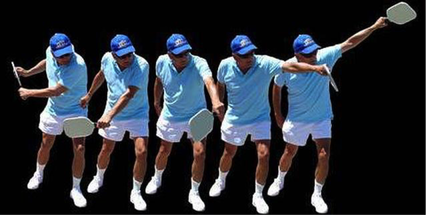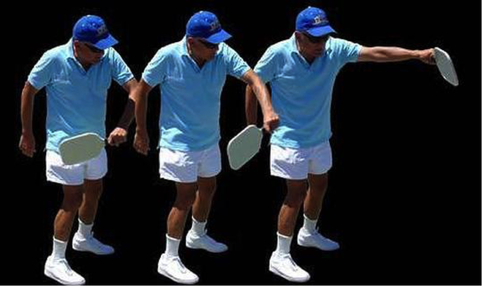The terms “easy” and “backhand” barely appear together because, for many pickleball players, the backhand is a difficult shot that they prefer to avoid at all costs–even if it means running all the way around the ball for a forehand shot. However, this method limits your skill level and prevents you from growing up the pickleball rankings.
Instead, why not accept your shortcomings and take the necessary measures to perfect the pickleball backhand? In this article, I will go over the fundamentals of the backhand serve and cover some useful techniques, so if you want to add the backhand serve to your pickleball arsenal, you’ve come to the right spot!
What is Backhand in Pickleball?
A backhand in pickleball is a shot done from the non-dominant side of the body. Backhand shots are executed by right-handed players by striking the paddle head to the left of the body, while left-handed players strike the paddle head to the right. Backhand strokes can be played with either a one-handed or two-handed grip. It is fairly unusual for pickleball players to find their backhand to be weaker than their forehand. The difference is that forehands are done with the palm facing forward, whereas backhands are executed with the knuckles facing forward.

Everyday acts, such as opening a door or extending a handshake, generally entail a palm-forward gesture. As a result, hitting forehands seems more intuitive and natural than hitting backhands, contributing to the widespread belief that the latter is a weaker part of a player’s skill set.
Types of Backhands
Here are some types of pickleball backhand shots:
Backhand Ground Stroke
The backhand groundstroke is a popular and powerful shot. This happens when the ball bounces before being returned across the net by the player. The backhand groundstroke is unique among backhand shots for its powerful strength.

Backhand Serve
Many pickleball players prefer to serve with their forehand, but have you ever wondered whether you can serve with your backhand in pickleball? Yes, and it is not only entirely legal, but it may also be a highly effective tactic. Backhand serves may be an unexpected and strong weapon in your game, catching opponents off guard and perhaps distressing their rhythm. This variation is generally unfamiliar to players, making it a wonderful addition to your repertoire.

Backhand Drop Shot
A backhand drop shot is a slow, short shot that hits over the net. You utilize a backhand grip, with your thumb on top of the grip’s broader half. Swing your arm forward and whack the ball with your racket face slightly open. You want the ball to land near to the net on the other side.

Backhand Volley
A pickleball backhand volley is a stroke played while the ball is still in the air, without allowing it to bounce. To learn the pickleball backhand volley technique, use a backhand grip with your thumb on top of the broader half of the grip. Maintain a solid and sturdy racket face as you swing your arm forward, hoping to make the ball travel quickly and away from your opponents. Pickleball backhand volley technique is essential for precision and control in your game.

Reverse Backhand Stroke
The reverse backhand stroke is yet another technique that some pickleball players employ to improve their backhand. This is when they hit the ball using the reverse side of their paddle rather than their usual backhand side. This allows them to make better use of their forehand side, which is often stronger and more flexible.

A reverse backhand stroke can be used to catch an opponent off guard with a new spin and angle or to reach balls that are too far away from the body to hit with a standard backhand. However, because it entails swiftly and properly twisting the paddle and altering the grip, this method takes a lot of practice and expertise.
How to Hit a Backhand in Pickleball Successfully with 5 Simple Steps
The backhand is one of the most significant abilities in pickleball. It is a stroke played with the back of the paddle facing the opponent, generally on the left side of the body for right-handed players. A strong backhand can help you return shots that your forehand cannot reach, as well as provide you additional options and angles to attack your opponent. Now is the moment to focus on improving your backhand by learning good footwork and understanding the core mechanics of a great stroke. Follow these five steps to improve your skills:
1. Grip the paddle correctly
The continental grip, which is the same grip used to hammer a nail, is the most frequent backhand grip. Hold the paddle in front of you with the edge perpendicular to the ground, and then secure your hand around the handle to obtain this grip. Your index finger and thumb should be slightly distanced from the rest of your fingers, with your thumb on the flat side of the handle. To increase your stability and power, you can also utilize a modified continental grip that is slightly rotated to the forehand side.

2. Position yourself well
To hit a decent backhand, you must first shift your feet and take a good stance. You should ideally be facing the side of the court, with your left foot just slightly in front of your right (for right-handed players). Bend your knees and lower your center of gravity to improve your balance and control. Keep your paddle in front of you, your face slightly open, and your arm relaxed and slightly bent at the elbow.

3. Swing the paddle
You must use your shoulder, arm, wrist, and core muscles to complete the backhand swing. Begin by drawing your paddle back, your elbow pointed behind you, and your wrist cocked. Then, with your shoulders and hips rotated towards the ball, swing the paddle forward, making contact with the ball in front of your body. Continue with your swing, wrapping up with your paddle over your opposing shoulder. To produce extra spin and speed, snap your wrist at the moment of impact.

4. Aim the shot
You must modify the angle of your paddle face and the direction of your swing to guide the ball where you want it to travel. To make it more challenging for your opponent to return the ball, hit it over the lowest point of the net and aim for the corners of the court. Depending on the scenario, you might alter the depth and height of your shot. For example, you can smash a low and deep drive to keep your opponent at bay, or a high and quick lob to go over their head. You can also alter the angle and direction of the ball by hitting a cross-court or down-the-line shot.

5. Practice the shot
The greatest approach to developing your backhand is to practice with a partner or a ball machine regularly. Start by hitting slow and simple shots, concentrating on technique and accuracy. Then, steadily improve the pace and strength of your shots while also practicing other backhand shots such as slices, drops, volleys, and overheads. You may also perform games and exercises that stress your backhand, such as playing exclusively with your backhand or hitting a specific objective on the court.

Conclusion
The pickleball backhand can make or break your game, whether you’re playing singles or doubles. It helps you in attacking, defending, and controlling the ball on your non-dominant side. You must practice the right grip, stance, footwork, swing, and contact point to learn the pickleball backhand. You should also study the many various types of backhand strokes, like the drive, drop, volley, and lob. You will be able to play with greater confidence, consistency, and power if you improve your pickleball backhand. Remember, the backhand is a weapon, not a weakness!
FAQs
If you can, it’s advised to utilize a continental grip for greater versatility and a better fit with pickleball’s particular requirements.
To increase the power of your backhand shots, focus on the right weight transfer from the back foot to the front foot, engage your core, and apply a slight wrist snap.
Position yourself correctly, anticipate the hit, and focus on quick reflexes to effectively block or return hard backhands.

